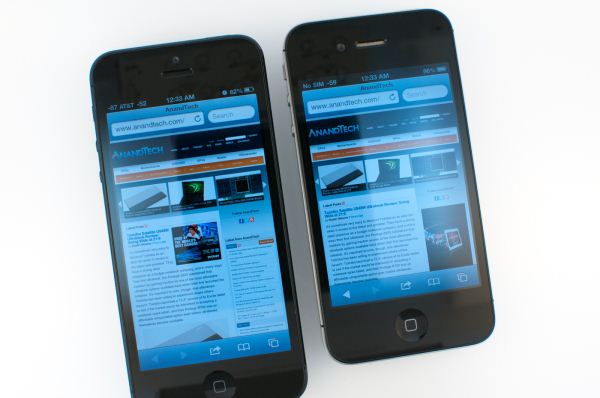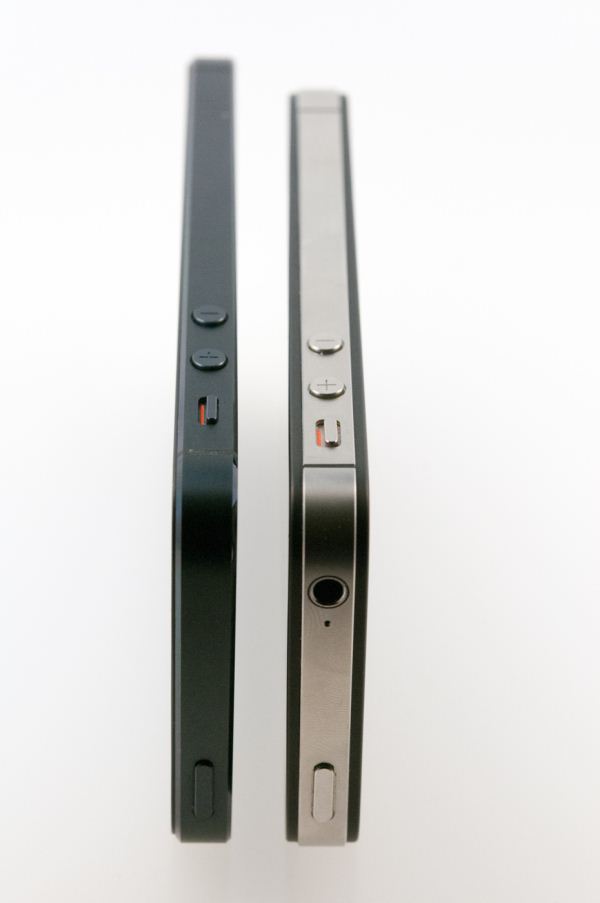The iPhone 5 Review
by Anand Lal Shimpi, Brian Klug & Vivek Gowri on October 16, 2012 11:33 AM EST- Posted in
- Smartphones
- Apple
- Mobile
- iPhone 5
The last significant redesign of the iPhone platform came in 2010 with the iPhone 4. It was an update that literally touched all aspects of the device, from SoC to display to baseband and of course, chassis. Last month’s launch of the iPhone 5 is no different in magnitude. The sixth generation iPhone makes some of the biggest changes to the platform since its introduction in 2007.
Visually the device begins by evolving the design language of the iPhone 4/4S chassis. From the launch of the iPhone 4 it was quite obvious that Apple had picked a design it was quite proud of. Thus it’s not too surprising that, from a distance, the iPhone 5 resembles the previous two iPhone models. We’ll get into material differences shortly, but what make the iPhone 5 design such a radical departure is its larger display.
All previous iPhones have maintained the same 3.5-inch, 3:2 aspect ratio display. With the rest of the world quickly moving to much larger displays, and with 16:9 the clear aspect ratio of choice, when faced with the decision of modernizing the iPhone platform the choice was obvious.
The iPhone 5 embraces a taller, 4-inch, 16:9 1136 x 640 display opting to lengthen the device instead of increasing its area in both dimensions. The result is a device that is distinctly an iPhone, albeit a modern one. The taller display doesn’t do much to make desktop web pages any easier to read as a result of the width staying the same. Those longing for an HTC One X or Galaxy S 3 sized device running iOS are out of luck. Reading emails and typing are both improved though as there’s now more room for lists and the keyboard no longer occupies as much of the display. The taller device can be more awkward to use if you have smaller hands, but the added screen real estate is honestly worth it. Once you get used to the iPhone 5’s display, going back to the older models is tough.
The taller chassis went on a diet as well. The iPhone 5 is now considerably thinner and lighter than its predecessor, which is yet another factor that contributes to it feeling more modern.
Internally the device changes are just as significant, if not more, than those on the outside. The iPhone 5 includes LTE support, which in areas where LTE networks are deployed can be enough reason alone to warrant an upgrade.
The iPhone 5 also includes a brand new SoC from Apple: the A6. For the first time since the introduction of the iPad, Apple has introduced a major branded SoC on an iPhone first. The iPhone 4 used the A4 after it debuted on the iPad, and the 4S picked up the A5 months after the iPad 2 launched with it. The A6 however arrives first on the iPhone 5, and with it comes two of Apple’s first, custom designed CPU cores. We’ve always known Apple as a vertically integrated device and software vendor, but getting into CPU design takes that to a new level.
| Physical Comparison | ||||
| Apple iPhone 4S | Samsung Galaxy S 3 (USA) | HTC One S | Apple iPhone 5 | |
| Height | 115.2 mm (4.5") | 136.6 mm (5.38" ) | 130.9 mm (5.15" ) | 123.8 mm (4.87") |
| Width | 58.6 mm (2.31") | 70.6 mm (2.78") | 65 mm (2.56") | 58.6 mm (2.31") |
| Depth | 9.3 mm ( 0.37") | 8.6 mm (0.34") | 7.8 mm (0.31") | 7.6 mm (0.30") |
| Weight | 140 g (4.9 oz) | 133g (4.7 oz) | 119.5g (4.21 oz) | 112 g (3.95 oz) |
| CPU | Apple A5 @ ~800MHz Dual Core Cortex A9 | 1.5 GHz MSM8960 Dual Core Krait | 1.5 GHz MSM8260A Dual Core Krait | 1.3 GHz Apple A6 (Dual Core Apple Swift) |
| GPU | PowerVR SGX 543MP2 | Adreno 225 | Adreno 225 | PowerVR SGX 543MP3 |
| RAM | 512MB LPDDR2-800 | 2 GB LPDDR2 | 1 GB LPDDR2 | 1 GB LPDDR2 |
| NAND | 16GB, 32GB or 64GB integrated | 16/32 GB NAND with up to 64 GB microSDXC | 16 GB NAND | 16, 32, or 64 GB integrated |
| Camera | 8 MP with LED Flash + Front Facing Camera | 8 MP with LED Flash + 1.9 MP front facing | 8 MP with LED Flash + VGA front facing | 8 MP with LED Flash + 1.2MP front facing |
| Screen | 3.5" 960 x 640 LED backlit LCD | 4.8" 1280x720 HD SAMOLED | 4.3" 960x540 Super AMOLED | 4" 1136 x 640 LED backlit LCD |
| Battery | Internal 5.3 Whr | Removable 7.98 Whr | Removable 6.1 Whr | Internal 5.45 Whr |
There’s a lot to talk about when it comes to the new iPhone. Whether it is understanding the architecture of the A6 SoC or investigating the improved low light performance of the iPhone 5’s rear facing camera, we’ve got it here in what is easily our most in-depth iPhone review to date. Let’s get started.












276 Comments
View All Comments
ArmedandDangerous - Tuesday, October 16, 2012 - link
What ever happened to the One X International review that was promised when you were reviewing the US version? Lots of promised articles and reviews that were never ever done...MrCake - Wednesday, October 17, 2012 - link
Yeah, already posted this comment for podcast 8, but it bears repeating. I'm less angry now, but still facepalming.It's not my expertise but I have designed a few hundred aluminum parts, so here's how it probably
works. The call-out is most likely equivalent to mil-std-171 7.2.2; this is a ~.0005" thickness coat,
decorative and scratch resistant. The coating itself is super hard, and can only be scratched by harder materials. The problem is the base metal yield strength is still fairly low. Chamfers (yes, we do pronounce the "h") have sharp edges, which make point contacts and therefore have theoretically infinite contact stresses till they're rounded off. To summarize; small contact areas, equal high pressures even at low forces; pressures over material yield cause deformations, and deformations over .0005" make you see silver. The chamfer finish is probably not a post anodization process,it's diamond ground and has a much finer surface finish. The rest of the phone is cnc milled, and is matte from either a sandblasting, or vibratory media process to remove machining marks. Anodize surfaces are as glossy/matte as their surface finish. And as to the "structural integrity" concern repeated, and repeated, and repeated; The iphone is thin, but the anodize coating is a couple orders of magnitude thinner and has negligible affect on structural integrity.
A possible fix would be mil-std-171 7.5.2 Anodize Type III which is an anodized hardcoat. It's a
similar process but coats to .002" thick, packs it's molecules much denser, and can pass a hardness test to rockwell C60. It's a reasonable response to the scratching issue, however it may not be appropriate for other reasons(prone to cracking instead of scratching, tolerance issues, more costly, less pretty.)
syxbit - Wednesday, October 17, 2012 - link
Great job guys. I'd appreciate it if you went into as much detail on the upcoming Nexus device(s).KPOM - Wednesday, October 17, 2012 - link
They will.WooDaddy - Wednesday, October 17, 2012 - link
I didn't RTFA (as if I need to question Anand consistently excellent analysis as it has been Anandtech's inception), but as soon as I saw the phrase 'murdered out' regarding the black/slate color, I was done. It was like Anand was at a poetry slam and he dropped the mic signifying that there is no one better.VivekGowri - Wednesday, October 17, 2012 - link
Hey, hey, I wrote that part :Pjuhatus - Wednesday, October 17, 2012 - link
iPhone review.. what about..Does it work as a phone??
SJD - Wednesday, October 17, 2012 - link
Don't know if I'm the first one to say this, but the HTC One S battery isn't removable. (At least it isn't over here in the UK - don't know if your version in the US is any different).Table - Physical Comparison - Page 1
Origin64 - Wednesday, October 17, 2012 - link
I do really want to point out that the iPhone 5 being 20% lighter than the 4 isn't really substantial, seeing as how a Galaxy S 1 weighs about half of that.Apple has excellent construction quality, but they build their phones from glass and aluminium and they are heavier than the competition. There's no advantage here, no breakthrough, the iPhone 5 is just a different design that has a thinner battery and less glass. It's not as interesting as you make it seem.
thunng8 - Wednesday, October 17, 2012 - link
What are you on about? The Galaxy S weighs 119g and the iphone 5 weighs 112g.